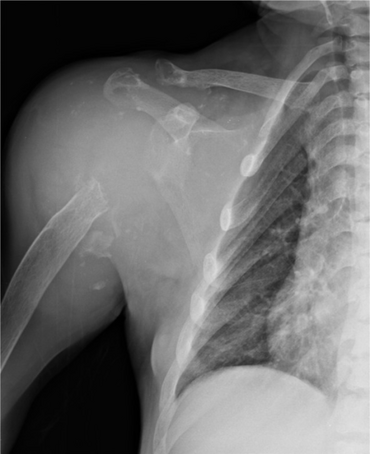Haemodialysis-associated amyloidosis
| Haemodialysis-associated amyloidosis | |
|---|---|
 | |
| Anteroposterior shoulder radiography of individual on renal replacement treatment | |
Amyloidosis is the accumulation on misfolded protein fibers in the body. This is very common condition associated with many of the chronic illness.
Haemodialysis-associated amyloidosis is a form of systemic amyloidosis associated with chronic kidney failure.[1] Even if this is common in CKD patients with chronic regular dialysis, it can be also seen in patient with CKD but have never dialysed too.[2]
Signs and symptoms
Long-term haemodialysis results in a gradual accumulation of β2 microglobulin, a serum protein, in the blood.[3] It accumulates because it is unable to cross the dialysis filter.
Affected individuals usually present after 5 years of dialysis rarely before that. The tendency of haemodialysis-associated amyloidosis is to be articular in general affecting the joints.
Diagnosis
Haemodialysis-associated amyloidosis can be diagnosed via the following:[4]
- Tissue biopsy
- Physical exam
The DDX should use computed tomography scan to establish, that the individual does not have infectious diskitis[4]
Prevention
The mainstay of management of the dialysis related amyloidosis is the prevention than the other type of treatment methods. Because most of the medical and surgical managements for this condition may not prevent the symptoms completely. Therefore we have to take adequate precautions to prevent future dialysis disequilibrium syndrome in CKD patients.
There are several steps in prevention of dialysis related amyloidosis.[5]
- Use of high flux dialyzers
- Use of Beta 2 globulin absorber
- Preserve the residual kidney functions
- Early kidney transplant
In addition low copper dialysis is theorized to prevent or delay onset.[6]
Management
Management of haemodialysis associated amyloidosis is symptomatic. Although there are lot of methods to prevent and delay the complications, probably the steroids and analgesics may helpful in the management of the condition.
However there are some surgical procedure to reduce the pain.
See also
References
- ↑ Miyata T, Oda O, Inagi R, et al. (September 1993). "beta 2-Microglobulin modified with advanced glycation end products is a major component of hemodialysis-associated amyloidosis". J. Clin. Invest. 92 (3): 1243–52. doi:10.1172/JCI116696. PMC 288264. PMID 8376584.
- ↑ Morinie`re P, Marie A, Esper NE et al. Destructive spondylarthropathy with b2-microglobulin deposits in a uremic patient before chronic hemodialysis. Nephron 1991; 59: 654–657
- ↑ Rapini, Ronald P.; Bolognia, Jean L.; Jorizzo, Joseph L. (2007). Dermatology: 2-Volume Set. St. Louis: Mosby. ISBN 978-1-4160-2999-1.
- ↑ 4.0 4.1 Scarpioni, R; Ricardi, M; Albertazzi, V; De Amicis, S; Rastelli, F; Zerbini, L (7 December 2016). "Dialysis-related amyloidosis: challenges and solutions". International Journal of Nephrology and Renovascular Disease. 9: 319–328. doi:10.2147/IJNRD.S84784. ISSN 1178-7058. Archived from the original on 8 November 2021. Retrieved 7 November 2021.
- ↑ "Dialysis Related Amyloidosis". Archived from the original on 2021-01-08. Retrieved 2021-01-07.
- ↑ "BU Amyloid Treatment & Research Program". Archived from the original on 2008-07-20.
External links
https://academic.oup.com/ndt/article-pdf/13/suppl_1/58/9896967/130058.pdf
| Classification | |
|---|---|
| External resources |